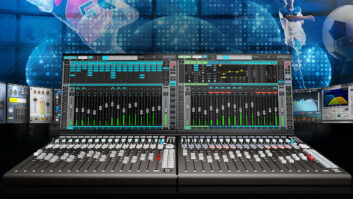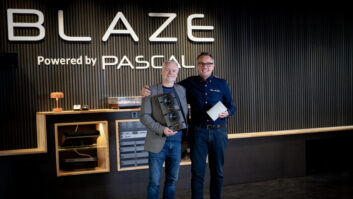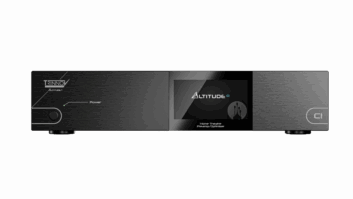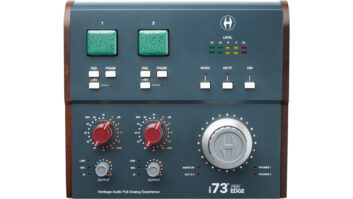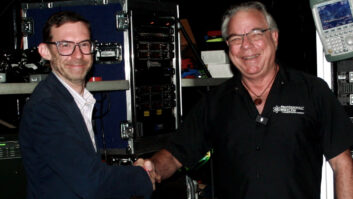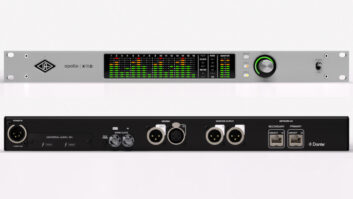Developing Zarkana’s audio was an ongoing process throughout the show’s two-year development. On hand for the final rehearsal before opening for previews were (l-r): Jean Michel Caron is the Assistant Sound Designer; Steve Dubuc, Sound Designer; and James Edmonson. Head of Audio/FOH engineer.
Since its founding by a group of street performers in 1984, Cirque du Soleil has grown to become an entertainment powerhouse, with tours and theatrical productions around the globe. Its latest creation is Zarkana, a $50 million “acrobatic rock opera” that follows a magician’s efforts to regain his magical powers and the love of his life. The epic show debuted in late July at New York’s Radio City Music Hall, where it is in residence through October 8.

Sound design for the production was tackled by Steve Dubuc, who has worked with Cirque du Soleil in various capacities on shows such as Quidam, Viva Elvis, Zaia and Zumanity. James Edmonson is Zarkana’s Head of Audio/FOH engineer, while Jean Michel Caron is the Assistant Sound Designer.
Cirque du Soleil’s theatrical productions typically undergo pre-staging rehearsals in Montreal with a small PA on hand, followed by extensive on-site rehearsals in the theaters they’ll call home. That wasn’t an option with a busy venue like Radio City, however, said Dubuc: “We brought in a full sound system minus the PA–front of house desk, monitor desk, all the monitoring system for the band, who worked in a small studio first before we brought them on stage [to be part of the show]. Eventually, we had to do a complete full-size rehearsal with the trapeze, and there aren’t theatres as big as Radio City anywhere else in North America, so we went to the Amway Arena in Orlando for two months before they tore it down, got things together and then went into Radio City for five weeks before we opened.”
Located in the center of Manhattan, Radio City Music Hall has its own house system based around QSC-powered JBL VerTec line arrays, which it typically encourages visiting productions—most noticeably concert tours—to use, since the system is configured and optimized for the room. While Zarkana has an extended residency, it’s still a touring production (next up: Spain and Russia) so Dubuc and his team brought in their own system based around Meyer Sound loudspeakers, LCS consoles and CueStation software used at FOH and monitor positions, and Meyer D-Mitri network modules that are racked within the onstage band’s two rolling risers.
While most theatrical productions roll like clockwork, thus allowing even the most infinitesimal cues to be set as scenes and recalled, working with a circus-style show is different. The LCS software stores many scenes, but there’s still plenty of manual mixing involved. All the music is played live, but if a segment runs long—say it takes a few tries for an acrobat to make a grand leap—the 10-piece live band and the engineers have to compensate. “This is more rock and roll mixed with theatrics,” said Caron. “You need to be on your toes and make sure you’re ready for anything that can happen.”
There’s a lot to keep track of as a result, with 240 inputs looked after at every show, ranging from the nearly 100 inputs from the band itself, to 24 wireless mics, to playback and more. Gear at the FOH position includes an Eventide H8000 Ultra-Harmonizer, TC Electronic-Helicon units for pitch-shifting and modulation, and an SSL XLogic that is inserted across all four primary vocalists. “They’re very musical compressors; I was quite surprised at how good they sound actually,” said Dubuc. “They’re not crazy expensive either which is good, plus they’re recallable.”
Despite the two-dozen wireless microphones and 20 channels of wireless personal monitors on-hand, the production hasn’t experienced any hits on the microphones, even though its in the center of Manhattan and across the street from NBC’s New York TV studios. Edmondson’s theory? “So far we’ve been very fortunate in that the frequency coordination that we did has been quite stable, but we also benefit from the architecture of the building. Above all of the coves in the ceiling is basically a latticework of iron struts and supports that seem to act as an oversized Faraday Cage.”
Hanging from the ceiling is a sizable Meyer Sound system based around two hangs of 16 Mica line array boxes and a half-dozen 700-HP subs per side, along with another eight Micas in a center fill position. Additional clusters hung on the sides of the house include nine Mina compact line array boxes a side. On the floor, bolstering audio to the first few rows of the orchestra are four JM-1Ps and two 700-HPs per side. On stage, Meyer UPQ boxes are used as monitors and sidefills for the trapeze artists, hung three per side above the stage.
Miking the production is an endeavor to itself, as most of the performers don’t speak or sing but require microphones for entirely different reasons—such as body percussion. “We tried a few tests on the body percussionist,” said Edmonson, “and we ended up with two wireless transmitters—one gets two DPA SMK4060s off of a Y-split to his feet and then there’s a single 4060 that lives in a wristband near his hands.”
As for the 10-piece band performing on stage, it’s heard via a variety of mics. Dubuc noted, “I tried a new mic I really like that Sennheiser makes, the MKH8040, which is a cardioid, and it’s actually a brilliant mic. It’s not cheap, but I love the sound of it.” Other mics gracing the two bandstands include Neumann vocal mics, as well as Audio-Technica 4040s and 4050s on African drums. Sennheiser MKH 8000 condensers capture shakers, while e904 cardioids are used on toms, an e902 resides on the kick and e906s grab the guitars.
All that gear on-hand gets put to good use, as the troupe performs 11 shows a week, making the heart-stopping acrobatics truly all in a day’s work. Between the split-second timing of the performers and the responsive sound effects and music mixing at the FOH position, Zarkana unquestionably has an air of magic around it.
Zarkana
www.cirquedusoleil.com/en/shows/zarkana/default.aspx
Meyer Sound
www.meyersound.com

